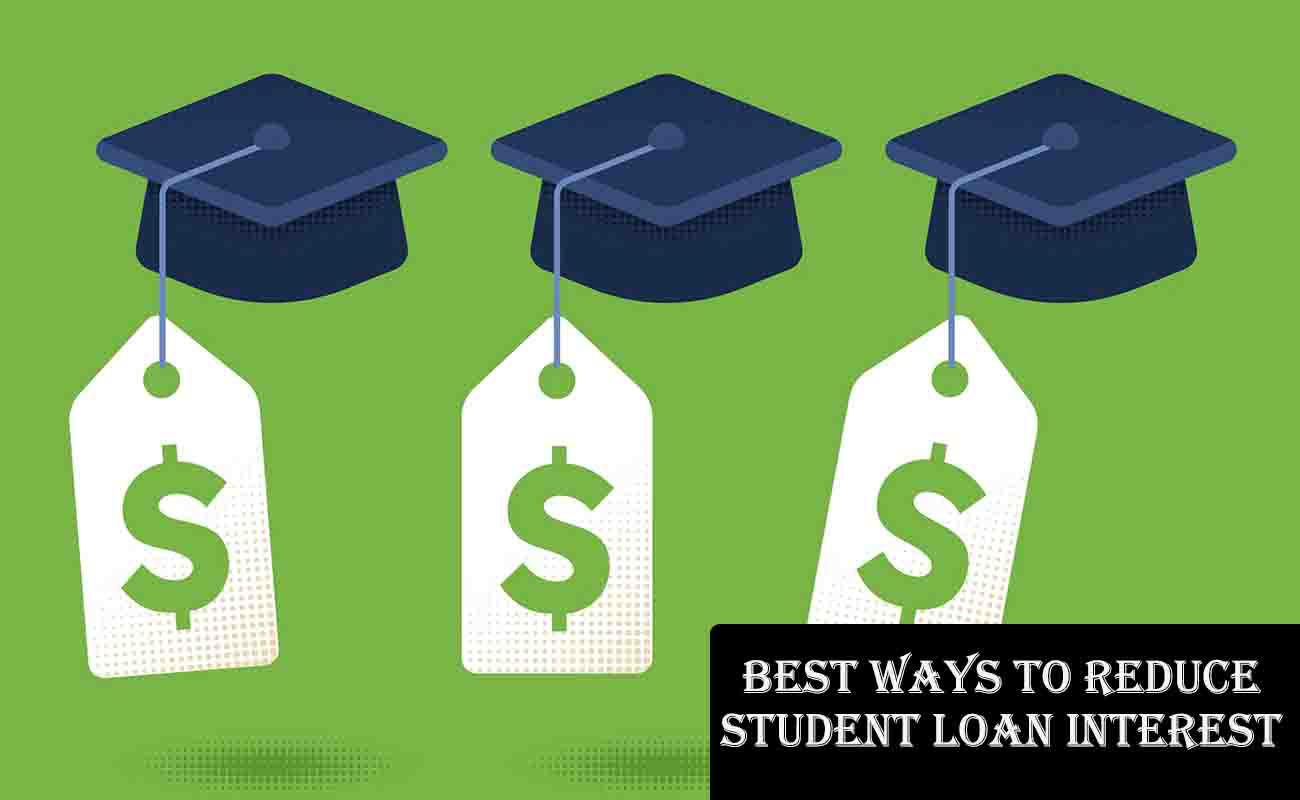I will share some tips on the Best Ways to Reduce Student Loan Interest. As someone who’s navigated the maze of student loans, I know how overwhelming it can feel to see interest piling up on your balance. Reducing student loan interest is a practical way to save money and pay off your debt faster.

When I graduated, my loans felt like a mountain I’d never climb, but over time, I learned strategies that helped me chip away at the interest and make real progress. In this article, I’ll share the best ways to reduce student loan interest, breaking down each method in simple terms so you can take control of your debt with confidence.
Whether you’re just starting repayment or looking to optimize your plan, I’ll walk you through actionable steps to lower your student loan interest. Let’s dive in and explore how you can save money and stress less about your loans.
Best Ways to Reduce Student Loan Interest
The first step to tackling student loan interest is understanding how it works and then taking deliberate actions to minimize it. Interest is the extra cost lenders charge for borrowing money, and on student loans, it can add thousands to your balance over time. Here are my top strategies to reduce that burden.
1. Make Extra Payments Toward the Principal
One of the most effective ways I found to reduce student loan interest is by making extra payments directly toward the principal, the original amount you borrowed. When you pay more than your required monthly payment, you can instruct your lender to apply the extra amount to the principal rather than future payments.
This lowers the balance that interest is calculated on, which means less interest accrues over time. For example, if your monthly payment is $300, try adding an extra $50 or $100 when you can. I used to cut back on small luxuries, like eating out, to free up cash for this.
Contact your loan servicer to ensure the extra payment goes to the principal—some lenders apply it differently unless you specify. Over time, this strategy can shave years off your loan term and save you hundreds, if not thousands, in interest.
2. Refinance Your Loans for a Lower Rate
Refinancing is another powerful tool to reduce student loan interest, but it’s not for everyone. When I refinanced my loans, I worked with a private lender to replace my existing federal or private loans with a new loan at a lower interest rate.
This can significantly cut the amount of interest you pay over the life of the loan, especially if you have a good credit score or a steady income. For instance, if you have a federal loan at 6.8% interest, refinancing to a 4% rate could save you thousands.
However, be cautious as refinancing federal loans means losing benefits like income-driven repayment or loan forgiveness. I weighed these pros and cons carefully before deciding. Shop around for lenders, compare rates, and check for fees. Sites like Credible or SoFi can help you find competitive offers tailored to your financial situation.
3. Enroll in Auto-Pay Discounts
Many lenders offer a small but meaningful interest rate discount—often 0.25%—if you sign up for automatic payments. I enrolled in auto-pay with my servicer, and while it didn’t seem like much at first, that tiny percentage added up over time.
Auto-pay ensures you never miss a payment, which also protects your credit score, and the discount directly reduces your interest rate.
Setting up auto-pay was simple: I linked my bank account through my lender’s online portal, and payments were deducted monthly. If you’re worried about overdrafts, keep a small buffer in your account.
Check with your loan servicer to confirm they offer this discount, it’s a low-effort way to save on interest without changing your repayment habits.
4. Explore Income-Driven Repayment Plans
If you have federal student loans, income-driven repayment (IDR) plans can help manage interest, especially if your income is low. I enrolled in an IDR plan when I was starting my career, and my salary couldn’t cover the high monthly payments.
These plans adjust your payments based on your income and family size, often lowering them significantly. Some plans, like PAYE or SAVE, even cap the interest that accrues on subsidized loans.
For example, under the SAVE plan, if your payment doesn’t cover the full interest, the government may cover the excess on subsidized loans for up to three years. This was a lifesaver for me early on. You’ll need to reapply annually, but the process is straightforward through StudentAid.gov.
Just know that lower payments might extend your loan term, so balance this with making extra payments when possible.
5. Pay More Frequently Than Monthly
Another trick I learned to reduce student loan interest is to make payments more often than once a month. For example, if your monthly payment is $400, consider paying $200 every two weeks. This results in 26 half-payments a year, equivalent to 13 full payments instead of 12.
That extra payment reduces your principal faster, cutting down on interest. I set this up by splitting my monthly budget and scheduling biweekly transfers to my loan servicer. It felt less daunting than finding a lump sum, and it became a habit.
Confirm with your lender that they don’t charge fees for frequent payments, as some may have restrictions. This strategy works best if you have steady cash flow and can commit to the schedule.
6. Take Advantage of Tax Deductions
You might not think of taxes as a way to reduce student loan interest, but the student loan interest deduction can help. I claimed this deduction when I was paying interest on my loans, and it reduced my taxable income by up to $2,500 a year.
That extra money in my tax refund went straight to my loan principal, indirectly lowering my interest costs. To qualify, your modified adjusted gross income (MAGI) must be below certain limits—$90,000 for single filers or $185,000 for joint filers in 2025.
You don’t need to itemize deductions to claim it; just file Form 1040 and include your loan interest from the 1098-E form your servicer provides. Check with a tax professional to ensure you’re eligible, but this is a straightforward way to put more money toward your loans.
7. Look Into Loan Forgiveness Programs
If you work in public service or certain professions, loan forgiveness programs can reduce or eliminate interest by forgiving part of your balance. I considered Public Service Loan Forgiveness (PSLF) when I worked for a nonprofit, as it forgives federal loans after 120 qualifying payments while working for a government or nonprofit employer.
During this time, interest still accrues, but forgiveness can wipe out the remaining balance, including interest. Other programs, like Teacher Loan Forgiveness or Nurse Corps Loan Repayment, offer similar benefits for specific careers.
Research eligibility on StudentAid.gov and track your payments carefully—PSLF, for example, requires precise documentation. If you qualify, these programs can be a game-changer for reducing your overall interest burden.
8. Negotiate with Your Lender
This one surprised me, but sometimes you can negotiate with private lenders to lower your interest rate. I called my lender during a period of financial strain and asked about options. While federal loans have fixed rates, private lenders may offer temporary rate reductions or forbearance if you’re proactive.
Be honest about your situation, and don’t be afraid to ask for a better rate, especially if your credit has improved. If negotiation doesn’t work, consider consolidating multiple private loans into one with a lower rate.
This isn’t the same as refinancing, as it may not change your rate drastically, but it simplifies payments and can sometimes secure a slight interest reduction. Always read the fine print to avoid hidden fees.
Additional Tips to Save on Interest
Beyond the core strategies, here are a few extra ways to keep interest in check:
- Pay Interest During School or Grace Periods: If you can afford it, pay the interest that accrues while you’re in school or during the six-month grace period after graduation. I wish I’d done this, as unpaid interest capitalizes, meaning it’s added to your principal and increases future interest.
- Use Windfalls Wisely: Bonuses, tax refunds, or gifts can go straight to your loan principal. I put a $1,000 tax refund toward my loans one year, and it made a noticeable dent in my interest.
- Avoid Unnecessary Deferment: Deferring payments can cause interest to pile up. If you must pause payments, explore forbearance options that don’t capitalize interest.
FAQs About Reducing Student Loan Interest
Q: Can I reduce interest without refinancing?
A: Yes, you can make extra payments, enroll in auto-pay, or use income-driven plans to manage interest without refinancing. These methods work well for federal loans, especially.
Q: Does refinancing hurt my credit score?
A: Refinancing may cause a small, temporary dip in your credit due to a hard inquiry, but consistent payments can improve your score over time. Check your credit before applying to ensure you qualify for the best rates.
Q: How do I know if I’m eligible for loan forgiveness?
A: Visit StudentAid.gov to check eligibility for programs like PSLF or Teacher Loan Forgiveness. You’ll need to meet specific job and payment requirements, so review the criteria carefully.
Q: Is the student loan interest deduction worth it?
A: If you pay at least $600 in interest annually and meet income requirements, the deduction can save you up to $2,500 on your taxes, freeing up money to pay down your loans faster.
Conclusion
Reducing student loan interest is a journey, but with the right strategies, you can save money and pay off your loans faster. From making extra payments to exploring forgiveness programs, I’ve shared the methods that helped me tackle my debt and that can work for you, too.
It’s about taking small, consistent steps and staying informed about your options. By applying these tips, you’ll be empowered to keep interest in check and move closer to financial freedom.

